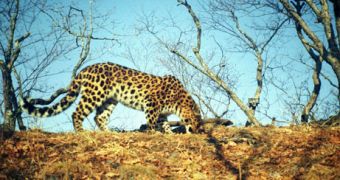This is the world's rarest big cat. Keeping this in mind, you can imagine how this was quite a hit: eight Amur leopards (Panthera pardus amurensis) were photographed by a camera trap in far southeastern Russia, in the Primorskiy region, at the border with China and North Korea.
The recent census showed that less than 40 Amur leopards (also known as Far Eastern leopards; the name Amur refers to the Amur River, the largest crossing that area) still roam the temperate forests of Russia's Far East and neighboring China. The camera traps were installed by the conservation group WWF and a local nonprofit organization, the Institute for Sustainable Use of Natural Resources.
"The confirmed stability of the leopard population ? warm[s] our hearts and give[s] hope. But this is only a small part of the leopard's habitat in the southwest Primorskiy. The remaining 70% of the leopard's habitat [is] in precarious condition," said Pavel Fomenko of WWF Russia.
A legal conservation strategy for the predator was adopted in 1998, but poaching for the illegal trade in leopard parts is still a huge threat. WWF has been fighting against poaching and has attempted to boost the population of hoofed prey species (deer and wild boars) in the leopard's habitat. "The goal of utmost importance is to create a unified federal protected area for the leopard, [and that] has not yet been achieved in Primorskiy," Fomenko said.
Previous images of the Far Eastern leopard in the wild had been taken in November 2006. The Amur leopard is the northernmost subspecies of the common leopard (or panther) that we get to see in documentaries from Africa to India and Borneo, unlike snow leopard and clouded leopard, which are distinct species.
This is the only common leopard adapted to harsh Siberian winters, that it must endure in its Far East habitat. It is also the largest leopard subspecies. The Amur Leopard is differentiated from the ten other living subspecies of leopard by its paler and longer fur, that can grow up to 7 cm (2.8 in) during the winter.
The same area is the home for the Siberian tiger, the largest cat and the most endangered subspecies of tiger. Currently, about 400 Siberian tigers live in the wild but less than 20 tigers in Southwest Primorye are isolated from the main population to the east and north, triggering concern about their genetic composition and vigor. Of course, the Amur leopard is far more endangered than the Siberian tiger, and concerns about the genetic status of this cat are even greater.

 14 DAY TRIAL //
14 DAY TRIAL //